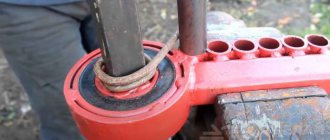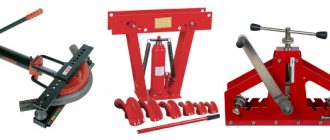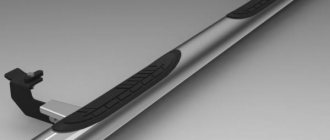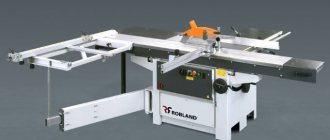When carrying out construction work, in most cases, it is necessary to erect concrete structures with the assembly of a reinforcing frame made of reinforcement. To create a reinforcing frame, you need both straight rods and bent rods in the form of clamps, “escos”, “pawns” and other structural elements. Manually bending steel bars with high precision is problematic, and buying a special machine for bending reinforcement for this purpose is not financially profitable. Therefore, making a reinforcement bender with your own hands will be an excellent solution.
Why can’t you do without a bender when reinforcing?
When laying a reinforcing belt, simply laying straight reinforcement will not allow achieving the calculated load-bearing capacities. This is due to the fact that the load on reinforced concrete structures is not always distributed evenly, as a result of which additional internal stresses may arise that can cause destruction.
An example of a reinforcing frame made of bent reinforcement A500C and A240. In order to achieve this shape of the frame, rods with a diameter of 25 mm were bent using a pipe bender, and clamps using a reinforcement bender.
A cold or hot rolled metal rod is quite brittle, so in some cases it is not able to withstand compressive and tensile loads, simply bursting. Therefore, bending it several times in one direction and then in the other direction will not work without reducing the final strength characteristics of the product.
Manually using simple devices it is not always possible to apply the necessary force to obtain the desired angle. Especially if it is necessary to give the reinforcement complex shapes. It is also not possible to make special fasteners, for example, hooks or clamps, for column reinforcement manually. Therefore, in such cases it is necessary to use a reinforcement bender (a machine for bending reinforcement).
How to avoid mistakes when bending reinforcement?
To maintain the strength properties of steel bars, it is important to ensure that when bending, an acute angle is not formed, and that the radius of curvature is 2.5-5 of their diameters. When bending by 900, the mechanical characteristics are completely preserved, but if exceeded, they begin to decrease.
To simplify the procedure for giving the reinforcement the desired shape, many people decide to heat it with a blowtorch or create a partial cut. This is strictly prohibited, since the reinforced structure will not comply with building codes.
Sharp bending is not recommended. That is, shock methods are unacceptable. As a result of mechanical influences, defects are created inside the metal and the structure changes.
To ensure that steel bars do not lose their initial strength characteristics, the bend radius of the reinforcement must be observed.
Requirements for bending reinforcing bars
For bending reinforcement of large cross-sections, powerful factory-made machines are used; for rods of small cross-sections, you can use hand-made devices made by yourself. Such homemade devices are quite suitable for bending mounting loops, hooks, and tabs. Homemade devices are used for bending rods with diameters of no more than 14 mm when it is necessary to bend small batches of reinforcement. Most often popular among private developers.
To maintain the performance characteristics of the rods when bending, the following conditions are observed:
- The bend angle should not be less than 90°.
- The radius of rounding at the bend is at least 10-15 diameters.
The equipment used must correspond to the diameter of the bars being processed and the strength class of the reinforcing steel, otherwise folds may form on the inside of the resulting angle, and cracks on the outside. Also important points are: correct adjustment of the device and reliable fixation of the rod.
It is not recommended to practice traditional methods using high-temperature effects, including the following steps:
- using a grinder to cut the bend of the reinforcing bar;
- heating the bend with a blowtorch or other open flame source;
- bending to the required angle.
When using this method, mechanical characteristics are reduced at the bend due to cuts and exposure to high temperatures. When exposed to loads on such a rod, it may collapse. If the project does not have permission to use this bending method, it is not recommended to use it.
Operating principle of a reinforcement bender
All bending machines work like this:
- The reinforcement is securely fixed in clamps or a vice on thrust rollers.
- Using the third roller, located in the bending area, a mechanical effect is applied to the reinforcement.
- When the required bending angle is reached, the force is removed and the product is detached from the machine.
The use of shafts prevents metal from tearing due to deformation. In more complex designs, multiple thrust shafts are used to produce bars with multiple bending points. Their goal is to reduce mechanical operations and simplify the production of products of the desired shape.
To apply mechanical force in manual structures, a lever is installed. Depending on the permissible loads, the machines allow you to bend several reinforcements at the same time. However, in this case, bending thick rods with a diameter of more than 14 mm will require considerable effort. To simplify this task, it is recommended to use a hydraulic drive.
Operating principle of reinforcement bending machines
The operating principle of self-produced and factory-produced bending machines is approximately the same:
- the metal product is placed between the central and thrust pins;
- using a bending pin, the rod is bent at the angle specified in the project;
- bending can be done to the right or left.
In devices with a mechanical drive, there is a rotating disk on which the central and bending fingers are fixed. A rod is placed in the gap between them. One end of the rod rests against a roller, which is permanently mounted on the body. As the disc rotates, the bending pin acts on the reinforcing bar, which bends to the required angle around the central roller.
Step-by-step instructions for creating a do-it-yourself reinforcement bender
To design a bending machine, it is necessary to go through a number of stages.
- Selection of drawing.
- Preparatory work.
- Assembly.
Each of them requires a clear understanding of the purposes for which the use of this equipment is required, as well as the competent distribution of allocated funds.
Selection of drawing
There is no point in reinventing the reinforcement bender, since many different drawings can be found in the public domain on the Internet that allow you to create effective, time-tested structures. This will simplify the search for the necessary materials, calculate cost estimates, select tools, and also allow you to estimate the amount of time for production.
An example of a drawing of a reinforcement bender with a bearing.
At the same time, it is worth understanding that you need to create a tool only for specific purposes, and not make it universal and, as a result, never use this functionality. If subsequently there is a need to expand functions, then it is better to use it later, having laid down a sufficient margin of safety for this.
Preparatory work
At the preparation stage, you need to decide on the following points:
- Decide for what purposes the reinforcement bender will be used.
- Select a drawing of the desired design. Make changes if necessary.
- Purchase materials.
- Select tools for assembly.
If the budget is limited, then in this case it is possible to create a lever design of the machine at the initial stages, and subsequently equip it with a hydraulic drive. It is important to create a machine base in which the safety margin will exceed the same parameter for the fittings by 3-5 times. Such data can be found from tables in reference books, so there should be no problems with this point.
Selection of tools
To create a reinforcement bender you must have the following tools:
- an angle grinder (builders call it a “grinder”) with a set of cutting and grinding discs for metal;
- electric drill with a set of metal drills;
- semiautomatic welding machine with a set of suitable electrodes;
- hammer, pliers, file, core;
- vice.
The use of power and hand tools is required to ensure high machining productivity as well as accurate part fitting.
Necessary materials
To create bending machines you will need:
- Steel corner with a side width of 75 mm, a length of 800 mm, a metal thickness of 5 mm.
- Steel rod with a diameter of 12 to 25 mm.
- Bolts with a diameter of 20 mm and a length of 50 mm, as well as washers for them.
- Additional devices, for example, a hydraulic drive, if its installation is provided for by the design.
It is important to create a massive structure that will ensure the stability of the machine when bending and applying force.
2 options for manufacturing a machine for bending reinforcement
The following designs of homemade reinforcement benders are considered the most popular:
- From the corner.
- From a bearing.
Corner machine
The procedure for making a device for bending reinforcement from a corner:
- The corners are cut to size as indicated in the drawing.
- The steel U-shaped profile is cut so that its length is 1 m. It will serve as a bed.
- A pin made of thick reinforcement is welded to the frame in the middle.
- We cut off a piece of pipe whose diameter allows it to be placed on the welded pin.
- A corner is welded perpendicular to the welded pin. Then a hole is drilled in it for the internal diameter of the pipe.
- The corner with the pipe is put on the pin. Then mark the place for welding the corner piece, remove the moving part and weld the second part of the corner.
- A piece of reinforcement is welded to the end of the movable structure. It will act as a lever. You need to attach a comfortable handle to the end opposite to the mount.
- Reinforcing legs are welded to the frame.
It is recommended to lubricate the bending axis to extend its service life by reducing friction of parts during operation.
There is a simpler design for a reinforcement bender made from a corner. You need 2 corners of 80 cm each, with a metal thickness of at least 5 mm. You will need studs, 3 pieces of 10-15 cm, and one 20 cm.
The procedure is as follows:
- We weld two pins to one of the corners, with the help of which we will attach the corner to the table.
- We weld a piece of tube on the edge to the second corner. This will be our moving part.
- We weld a pin to the other end of the corner. We put a piece of pipe on it and screw two nuts. This will be our handle.
The simplest, homemade machine for bending reinforcement from a corner.
Simplicity of design and mobility allow it to be transported from one construction site to another and attached to any table; the machine will be an excellent assistant in reinforcing strip foundations, floors and other reinforced concrete structures. This reinforcement bender allows you to bend reinforcement with a diameter of up to 14 mm.
Device for bending reinforcement with a bearing
The production of a machine from a bearing for bending reinforcement is implemented as follows:
- From a square pipe 40x40 mm it is necessary to cut a piece 300-350 mm long. Drill holes in it with a diameter of 12 mm for installing bolts for fastening.
- On one side you need to insert the nuts and weld them to the profile, and then make a cut to install the bushing for the bearings and weld it. It is important that the bushing is of the correct shape without defects or dents.
- In a piece of 40x40 mm profile, you need to make cuts to attach the bushing to the shock-absorbing rod. A lever made from a half-inch diameter pipe needs to be welded to it.
- From a 32x23 mm corner you need to cut a piece 250 mm long, and then weld it to the profile with a small allowance of 15 mm for structural reliability. Then you need to insert a support made of a steel strip.
- To create a movable limiter, a steel plate and a pin are used.
- The lever is welded to the base of the structure. After this, the bearings are inserted into place and the machine is assembled.
Before operation, you need to check the functionality of the structure on steel rods with a diameter of up to 10 mm. Only after this can maximum loads be applied.
How to make machines for bending reinforcement of the simplest design?
The simplest device is a piece of channel with slots. Using such a primitive device, it is possible to bend rods with a diameter of up to 8 mm with a sufficiently large bending angle radius. The bending procedure requires serious physical effort.
To independently manufacture a more complex bending device, you will need: a steel corner 40x40 mm, a wooden block, fasteners. It is not difficult to assemble such a homemade machine for bending reinforcement, but it is only suitable for bending rods of small cross-section, mainly for making mounting loops and other products from reinforcement with a smooth surface.
Stages of work:
- the corner is cut into 2 parts;
- holes are made in one of the parts for self-tapping screws, then this section is attached to a wooden block;
- the second part is movable, attached to the block with a bolt, and performs the functions of a lever.
The use of this design does not provide high productivity and requires significant physical effort.
A similar design can be made not on a beam, but on a channel or profile pipe. The maximum diameter of processed reinforcing bars is 14 mm.
Tips and tricks for making rebar benders
When making a bending machine for reinforcement with your own hands, it is important to follow a number of tips and recommendations:
- All structural elements should be selected with a margin of safety. Saving on one of the parts can lead to a number of problems and require significant financial investments to restore the functionality of the reinforcement bender.
- Before starting work, you need to make sure that the parts are assembled correctly and are securely fastened.
- It is recommended to use parts made of alloy or tool steel, as they can withstand significant loads and ensure the maximum possible durability of the machine.
- It is important to decide in advance on the type of design so that it provides the necessary functionality. It is not possible to make alterations in the future in all cases, and manufacturing several machines is not always financially profitable.
Despite the apparent simplicity of the design of the machine, its assembly should be taken seriously. The parts must be adjusted as closely as possible to avoid problems during operation and rejection of the reinforcement.
You can make a reinforcement bender with your own hands without any problems. Its cost, even taking into account the time spent on creation and the purchase of materials, will be tens of times lower than the purchase of a machine made industrially. It will cope with its tasks in the same way, but at the same time, knowing its design, you can easily repair and maintain it, and, if necessary, even improve the design.
Design and purpose of a bending machine
In the simplest case, a machine for bending reinforcement includes a casing and a working mechanism. The first serves as the base on which the second is attached and rotates. Without a reliable base, you will not be able to bend the reinforcement well - it must be securely fixed. The movement of the reinforcing rod (except for that part of it that bends in the desired direction) must be completely eliminated.
There are at least a dozen different drawings of the simplest homemade manual bending machine - they differ in the size of the working parts of the device.
But all these reinforcement benders are united by a common principle: the reinforcement cannot be bent sharply and at an acute angle - no matter how thick or thin the rod itself is. The basic rule for bending reinforcement is that the radius of the bent section must be at least 10 and no more than 15 diameters of the rod itself. An underestimation of this indicator threatens to break the reinforcement, which will sharply worsen the operational parameters of the frame assembled from rods. If it is too high, the structure, on the contrary, will not have sufficient elasticity.
Properties
Conventional reinforcement is smooth or corrugated steel rods of various shapes, lengths, and cross-sections. They come in metal and, in addition to strengthening concrete products, are successfully used for installing fences. In recent years, polymer ones have gained wide popularity.
Scheme and patterns for fencing made of reinforcement
It has the same quality characteristics as any metal fence. Preparation and pouring of the foundation are carried out according to the same principles. In addition, such a fence has good maintainability. Individual parts can be updated or replaced without much difficulty using welding. In most cases, budget fences are used to surround summer cottages without any special frills. The protective functionality of fences is very important there. Their installation is simple and can be done by a home handyman.
Fence made of reinforcement and brick posts
For a fence, it is better if it is smooth, round in cross-section, 25 mm thick. It is good to use for both longitudinal and transverse parts. It has a high level of strength and corrosion resistance. There are no restrictions when welding.
Metal garden crafts or what to do with old shovels - photo ideas
It’s not at all difficult to create crafts for the garden from metal with your own hands if you have, for example, old shovels or other garden tools that have expired. After all, country crafts made from shovels do not require special skills and are made using simple welding methods.
What can be made from an old shovel at the dacha
With the help of these photos with ideas, you will easily understand how to decorate your dacha, and at the same time get rid of unnecessary junk in the barn. And old shovels that have served their purpose will turn into interesting masterpieces of landscape design, fitting perfectly among flower beds and garden topiary figures.
Crafts made from shovels very successfully create images of various animals. And while walking through the garden, it will be very unusual to meet a heron standing near the dacha pond or a ladybug crawling towards the onion alpine hill.
Crafts from shovels photo
A family of shovel owls, a cat with flowery fur, an aquarium fish and even a goat will get along well in different parts of the garden along with a homemade garden scarecrow. Crafts can be painted with enamel paint, after removing the rust from the tools, coated with metal varnish, or left in their natural rusty form.
Let's sum it up
Having decided on the design of the device, you can independently make a bending mechanism designed to give steel bars the required shape. It is important to take a responsible approach to developing documentation. You should use verified drawings from which the bending equipment was manufactured, or create a sketch of a full-scale sample yourself. There is a wide field of activity available for home craftsmen. The result is a self-made bending device, the use of which will save money.











